Research on a Fault Diagnosis Method for Rolling Bearings Based on the Fusion of PSR-CRP and DenseNet
Abstract
1. Introduction
- To address the issue of nonlinearity and poor smoothness in bearing vibration signals, one-dimensional vibration signals are extended into three-dimensional phase space using phase space reconstruction technology. This approach effectively expands the system state space and provides a more comprehensive characterization of the system’s operational condition;
- To address the issue of obscure fault characteristics in traditional recurrence plots caused by inappropriate selection of the recurrence threshold, a color recurrence diagram is employed. Specifically, the Euclidean distances between phase points in the reconstructed phase space are computed to construct a distance matrix, which is then mapped onto the Magma colormap. The continuous color transitions in this representation enhance the visibility of fault features;
- To address the challenge of limited training samples and weak fault features, DenseNet is selected. Its densely connected topology enables efficient feature reuse and facilitates comprehensive utilization of feature information, thereby enhancing fault feature extraction and classification performance.
2. Theoretical Analysis
2.1. Phase Space Reconstruction and Color Recurrence Plot Construction (PSR-CRP)
2.1.1. Phase Space Reconstruction Theory
2.1.2. Color Recurrence Plot
2.2. DenseNet
2.3. Model Evaluation Methodology
3. Experimental Data
3.1. CWRU Public Datasets
3.2. Jiangnan University Dataset
4. Fault Diagnosis
4.1. Signal Processing
4.2. Comparison of Recurrence Plots Among Different Fault Types
4.3. PSR-RP-DenseNet Diagnostic Model
4.4. Comparison with Other Diagnostic Models
5. Conclusions
- (1)
- The currently utilized dataset does not encompass all practical application scenarios. Future work will focus on expanding the dataset to incorporate various types of bearings, diverse operating conditions (e.g., varying loads, speeds, and temperatures), and multiple failure modes. This enhancement is expected to strengthen the model’s generalization capability and adaptability;
- (2)
- Multimodal feature fusion strategies should be investigated, integrating multi-source information such as rotational speed, temperature, and load into the deep learning model, and design a multi-input network architecture to enable collaborative utilization of multi-dimensional features. Meanwhile, attention should be given to the sampling frequency synchronization across different modalities to avoid bias in multimodal feature fusion caused by temporal domain discrepancies;
- (3)
- Further optimization of the model structure can reduce its complexity and enhance the model’s real-time inference capability, thereby better meeting the practical requirements of online monitoring and fault diagnosis. The application of the optimized model might be extended to a broader range of industrial scenarios to validate its stability and adaptability across diverse operating conditions.
Author Contributions
Funding
Data Availability Statement
Conflicts of Interest
References
- Zhang, J.; Wu, J.; Hu, B.; Tang, J. Intelligent fault diagnosis of rolling bearings using variational mode decomposition and self-organizing feature map. J. Vib. Control 2020, 26, 1886–1897. [Google Scholar] [CrossRef]
- Rai, A.; Upadhyay, S.H. A review on signal processing techniques utilized in the fault diagnosis of rolling element bearings. Tribol. Int. 2016, 96, 289–306. [Google Scholar] [CrossRef]
- Zhang, B.; Wang, W.; He, Y. A hybrid approach combining deep learning and signal processing for bearing fault diagnosis under imbalanced samples and multiple operating conditions. Sci. Rep. 2025, 15, 13606. [Google Scholar] [CrossRef] [PubMed]
- Chandrvanshi, S.; Sharma, S.; Singh, M.P.; Singh, R. Bearing Fault Diagnosis Using Machine Learning Models. In Proceedings of the International Conference on Micro-Electronics and Telecommunication Engineering, Ghaziabad, India, 22–23 September 2023; Springer Nature: Singapore, 2023; pp. 219–233. [Google Scholar]
- Nie, Y.; Li, F.; Wang, L.; Li, J.; Li, Y.; Sun, M.; Wang, M.; Li, G. A novel vibration model for explanation of the frequency features in multistage wind turbine gearboxes considering the effects of inter-stage meshing frequency modulation. Int. J. Precis. Eng. Manuf.-Green Technol. 2023, 10, 151–166. [Google Scholar] [CrossRef]
- Satish, C.R.; Kilmer, K.R.; Jiang, J.; Zhou, X.; Tan, L. Deep Learning Based Bearing Fault Detection Using Multi-Rate Signal Processing for Regulating Shaft Rotational Speed. In Proceedings of the SoutheastCon 2025, Concord, NC, USA, 22–30 March 2025; pp. 390–395. [Google Scholar]
- Zheng, L.; Xiang, Y.; Luo, N. Nonlinear dynamic modeling and vibration analysis for early fault evolution of rolling bearings. Sci. Rep. 2024, 14, 23687. [Google Scholar] [CrossRef]
- Zhang, R.; Guo, L.; Zong, Z.; Gao, H.; Qian, M.; Chen, Z. Dynamic modeling and analysis of rolling bearings with rolling element defect considering time-varying impact force. J. Sound Vib. 2023, 562, 117820. [Google Scholar] [CrossRef]
- Otava, L.; Buchta, L. Permanent magnet synchronous motor stator winding fault detection. In Proceedings of the IECON 2016-42nd Annual Conference of the IEEE Industrial Electronics Society, Florence, Italy, 23–26 October 2016; IEEE: Piscataway, NJ, USA, 2016; pp. 1536–1541. [Google Scholar]
- Zeng, C.; Huang, S.; Lei, J.; Wan, Z.; Yang, Y. Online Rotor Fault Diagnosis of Permanent Magnet Synchronous Motors Based on Stator Tooth Flux. IEEE Trans. Ind. Appl. 2021, 57, 2366–2377. [Google Scholar] [CrossRef]
- Surendran, R.; Khalaf, O.I.; Tavera Romero, C.A. Deep learning based intelligent industrial fault diagnosis model. Comput. Mater. Contin. 2022, 70, 6323–6338. [Google Scholar] [CrossRef]
- Yin, C.; Lee, H.P.; Ko, J.H.; Wang, Y. Intelligent Fault Diagnosis of Rolling Bearings in Strong Noise Environment: An Attention-Driven Hybrid Model Based on IENEMD and Parallel Multiscale CNN. Int. J. Precis. Eng. Manuf.-Green Technol. 2025, 12, 1091–1116. [Google Scholar] [CrossRef]
- Wei, L.; Peng, X.; Cao, Y. Intelligent fault diagnosis of rolling bearings in strongly noisy environments using graph convolutional networks. Int. J. Adapt. Control Signal Process. 2024, 39, 1469–1482. [Google Scholar] [CrossRef]
- Saha, D.K.; Hoque, M.E.; Badihi, H. Development of Intelligent Fault Diagnosis Technique of Rotary Machine Element Bearing: A Machine Learning Approach. Sensors 2022, 22, 1073. [Google Scholar] [CrossRef]
- Lei, L.; Li, W.; Zhang, S.; Wu, C.; Yu, H. Research Progress on Data-Driven Industrial Fault Diagnosis Methods. Sensors 2025, 25, 2952. [Google Scholar] [CrossRef]
- Gu, X.; Xie, Y.; Tian, Y.; Liu, T. A Lightweight Neural Network Based on GAF and ECA for Bearing Fault Diagnosis. Metals 2023, 13, 822. [Google Scholar] [CrossRef]
- Guo, L.; Zhang, L.; Huang, Q. Bearing Fault Diagnosis Based on Multi-Channel GAF-MTF and Res2Net. In Proceedings of the 2023 35th Chinese Control and Decision Conference (CCDC), Yichang, China, 20–22 May 2023; IEEE: Piscataway, NJ, USA, 2023; pp. 5321–5327. [Google Scholar]
- Mengjiao, W.; Liting, D. A new fault diagnosis of rolling bearing based on phase-space reconstruction and convolutional neural network. Ind. Lubr. Tribol. 2023, 75, 875–882. [Google Scholar] [CrossRef]
- Jiang, Y.; Xie, J. VMD–RP–CSRN Based Fault Diagnosis Method for Rolling Bearings. Electronics 2022, 11, 4046. [Google Scholar] [CrossRef]
- Yousuf, L.S. Influence of nonlinear dynamics behavior of the roller follower on the contact stress of polydyne cam profile. Processes 2022, 10, 585. [Google Scholar] [CrossRef]
- Zhao, H.; Liu, H.; Xu, J.; Deng, W. Performance prediction using high-order differential mathematical morphology gradient spectrum entropy and extreme learning machine. IEEE Trans. Instrum. Meas. 2019, 69, 4165–4172. [Google Scholar] [CrossRef]
- Zhou, J.; Xiao, M.; Niu, Y.; Ji, G. Rolling bearing fault diagnosis based on WGWOA-VMD-SVM. Sensors 2022, 22, 6281. [Google Scholar] [CrossRef] [PubMed]
- Zeng, Z.; Yang, J.; Wei, Y.; Wang, X.; Wang, P. Fault Detection of Flexible DC Distribution Network Based on GAF and Improved Deep Residual Network. J. Electr. Eng. Technol. 2024, 19, 3935–3945. [Google Scholar] [CrossRef]
- Wang, Z.; Shen, J.; Zhang, X.; Yu, Y.; Wang, Y.; Zhu, H.; Zhang, L. Gear fault diagnosis research based on GAF-TFR-2DCV with small sample size. Ain Shams Eng. J. 2025, 16, 103344. [Google Scholar] [CrossRef]
- Wang, M.; Wang, W.; Zhang, X.; Iu, H.H.-C. A new fault diagnosis of rolling bearing based on Markov transition field and CNN. Entropy 2022, 24, 751. [Google Scholar] [CrossRef] [PubMed]
- Ma, D.; Liu, Z.; Gao, Q.; Yao, J.; Zhao, X.; Zhang, Z. Few-shot fault diagnosis of EHA based on MTF-ResNet-MA and dual-attribute adaptive decision-level fusion. Measurement 2025, 247, 116787. [Google Scholar] [CrossRef]
- Lei, C.; Miao, C.; Wan, H.; Zhou, J.; Hao, D.; Feng, R. Rolling bearing fault diagnosis method based on MTF-MFACNN. Meas. Sci. Technol. 2023, 35, 035007. [Google Scholar] [CrossRef]
- Cong, F.; Chen, J.; Dong, G.; Zhao, F. Short-time matrix series based singular value decomposition for rolling bearing fault diagnosis. Mech. Syst. Signal Process. 2013, 34, 218–230. [Google Scholar] [CrossRef]
- Packard, N.H.; Crutchfield, J.P.; Farmer, J.D.; Shaw, R.S. Geometry from a time series. Phys. Rev. Lett. 1980, 45, 712. [Google Scholar] [CrossRef]
- Takens, F. Detecting strange attractors in turbulence. In Dynamical Systems and Turbulence, Warwick 1980, Proceedings of a Symposium Held at the University of Warwick 1979/80; Springer: Berlin/Heidelberg, Germany, 2006; pp. 366–381. [Google Scholar]
- Tan, X. Predictive analysis of economic chaotic time series based on chaotic genetics combined with fuzzy decision algorithm. Complexity 2021, 2021, 5517502. [Google Scholar] [CrossRef]
- Li, D.; Cao, M.; Manoach, E.; Ragulskis, M. A novel embedding method for characterization of low-dimensional nonlinear dynamical systems. Nonlinear Dyn. 2021, 104, 125–148. [Google Scholar] [CrossRef]
- Huang, G.; Liu, Z.; Van Der Maaten, L.; Weinberger, K.Q. Densely connected convolutional networks. In Proceedings of the IEEE Conference on Computer Vision and Pattern Recognition, Honolulu, Hawaii, 21–26 July 2017; pp. 4700–4708. [Google Scholar]


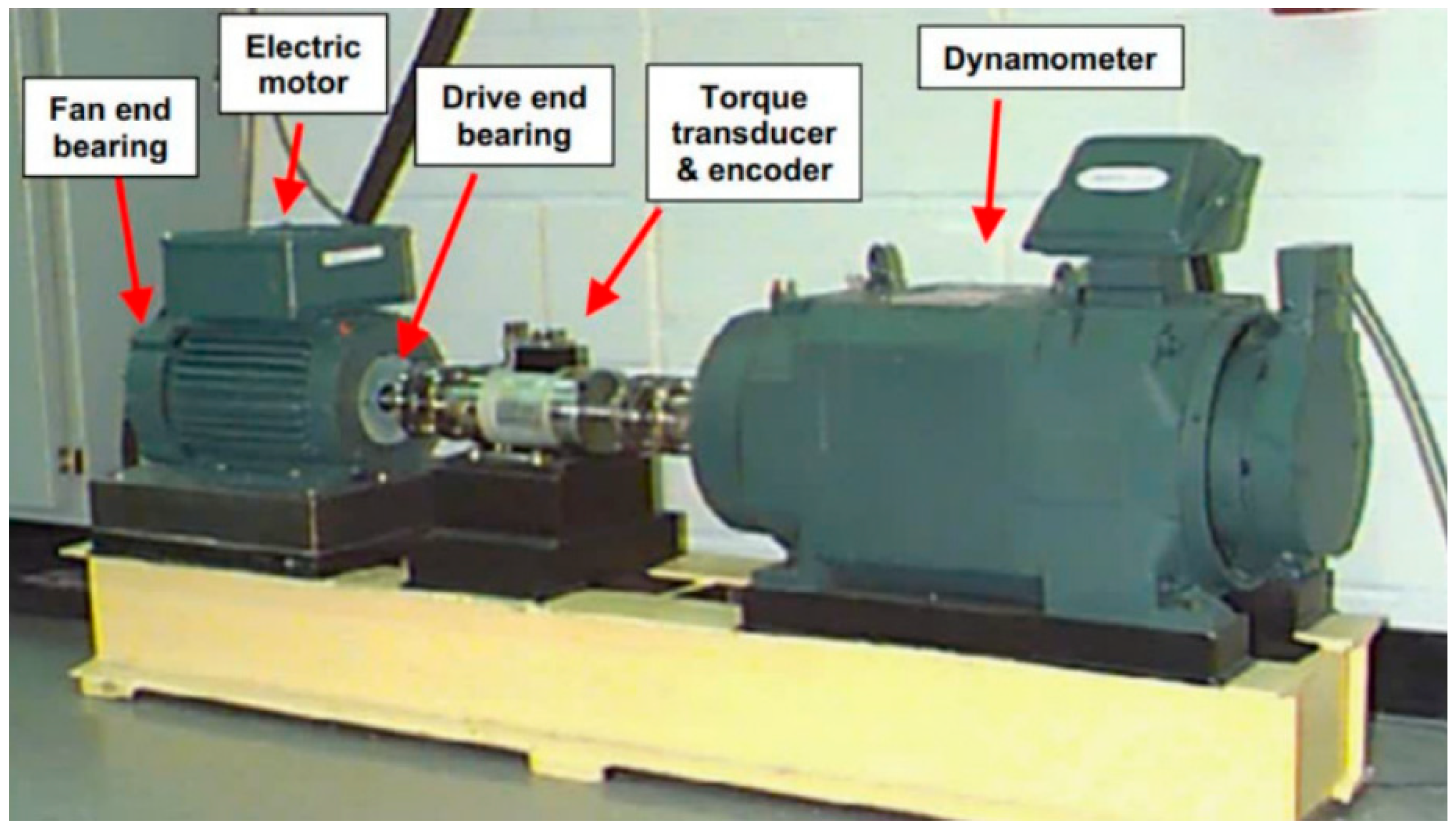


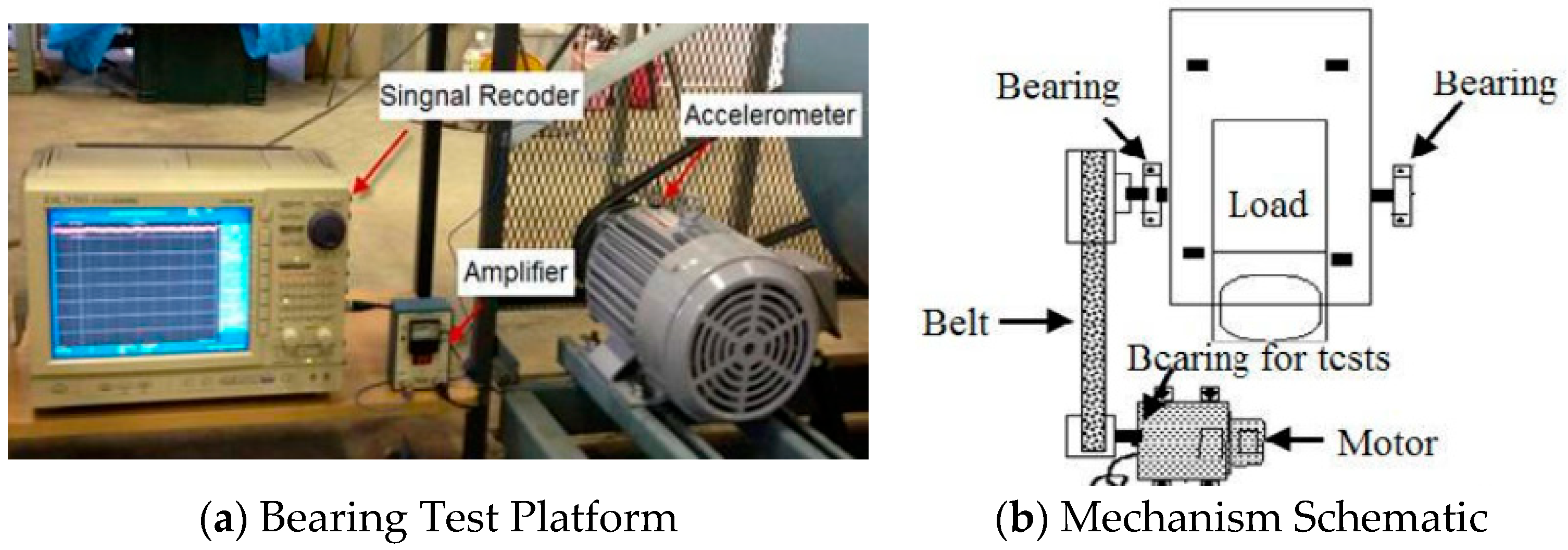
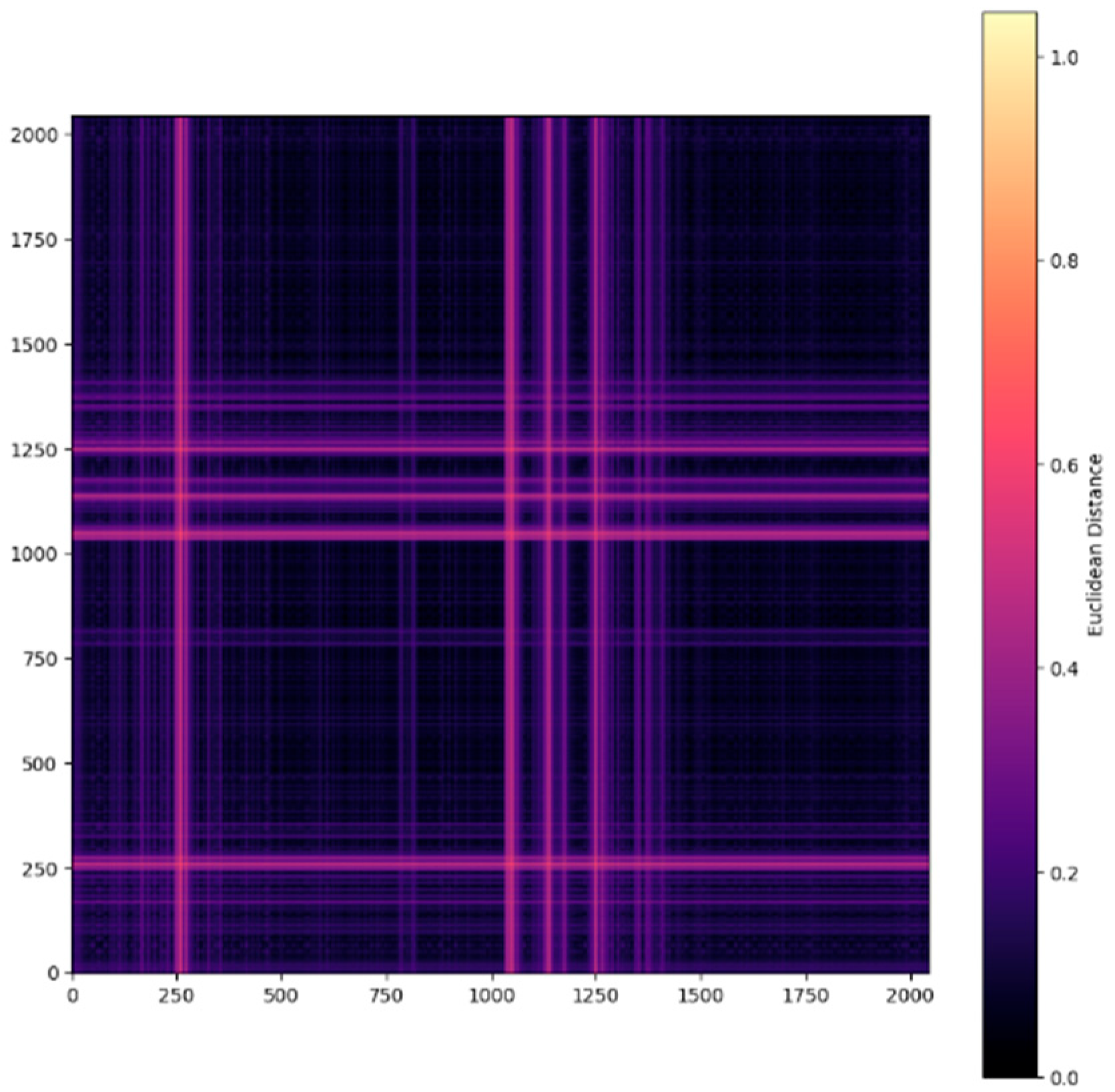
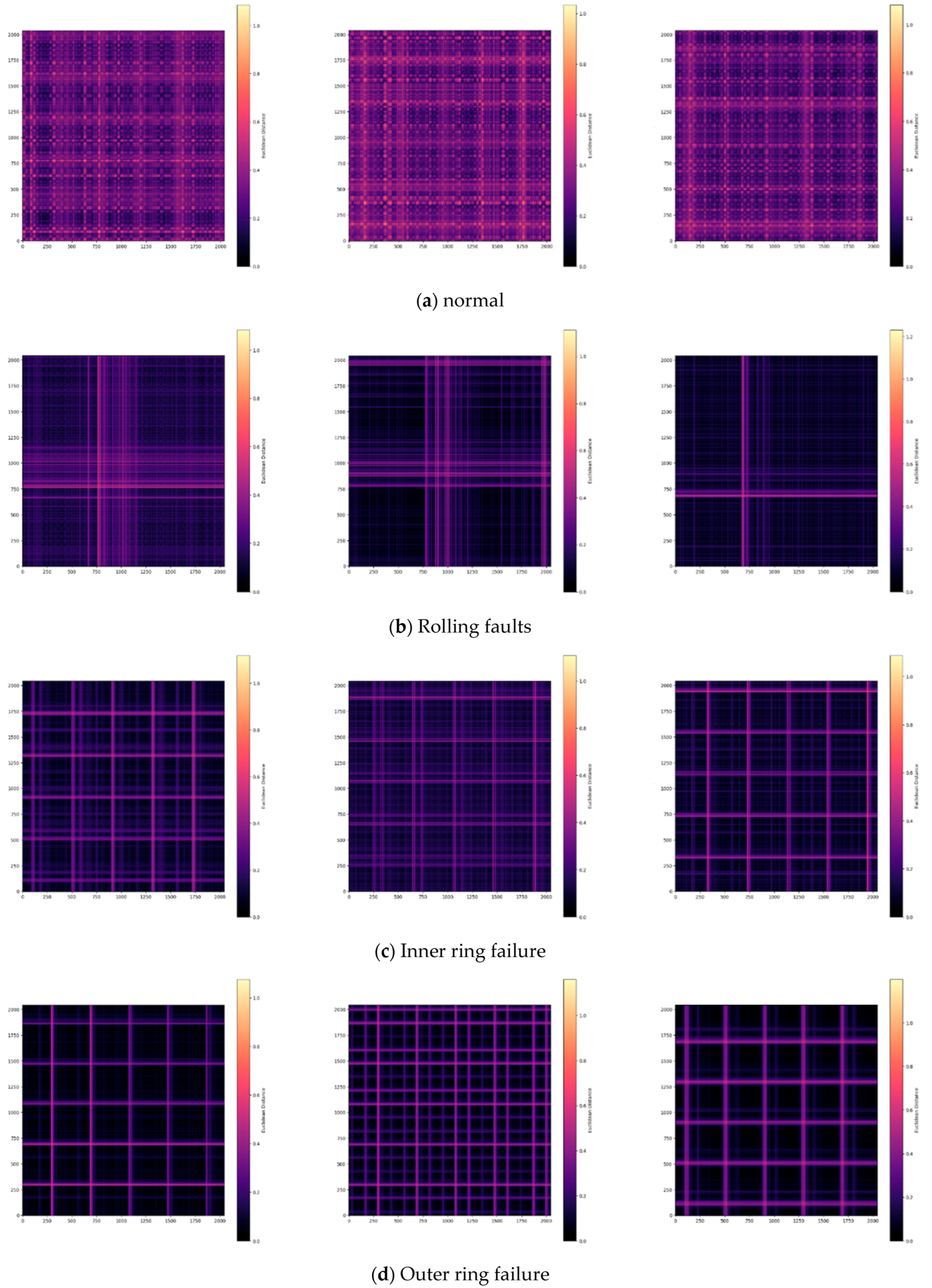
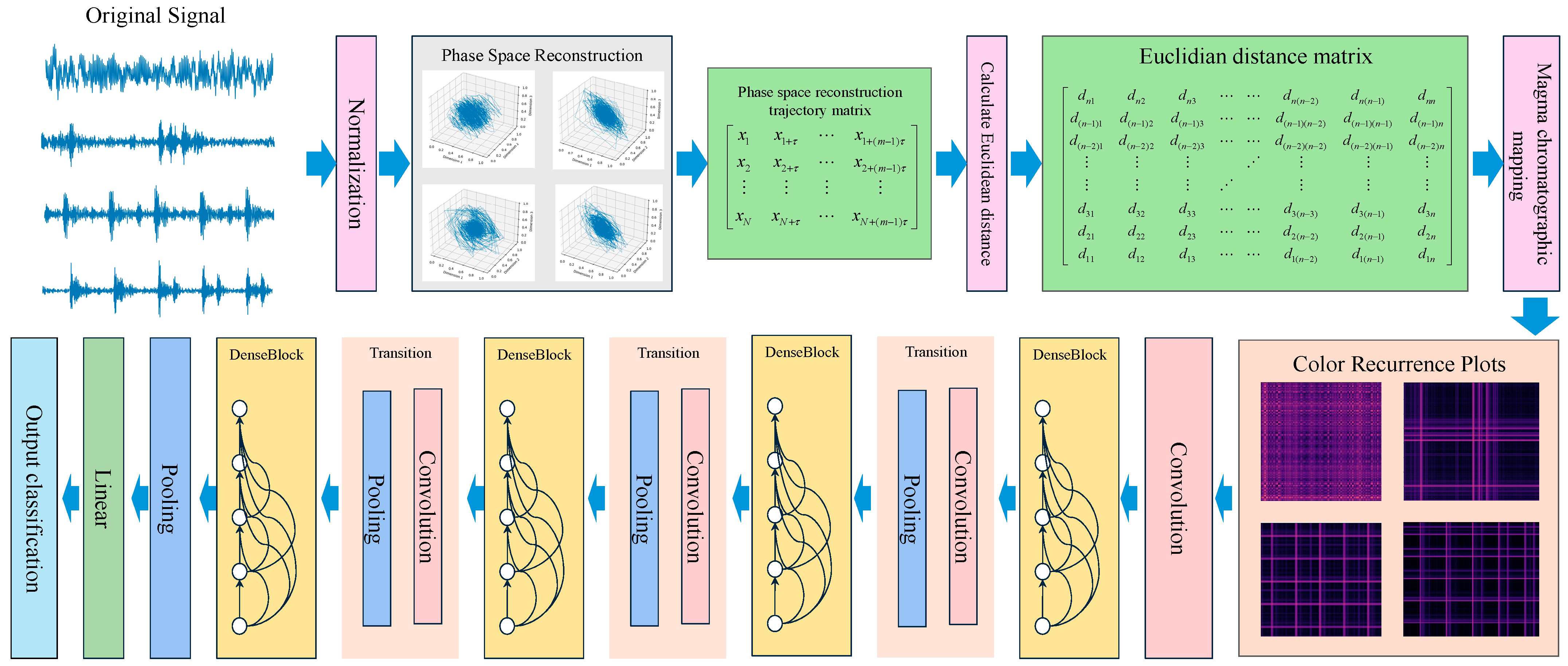
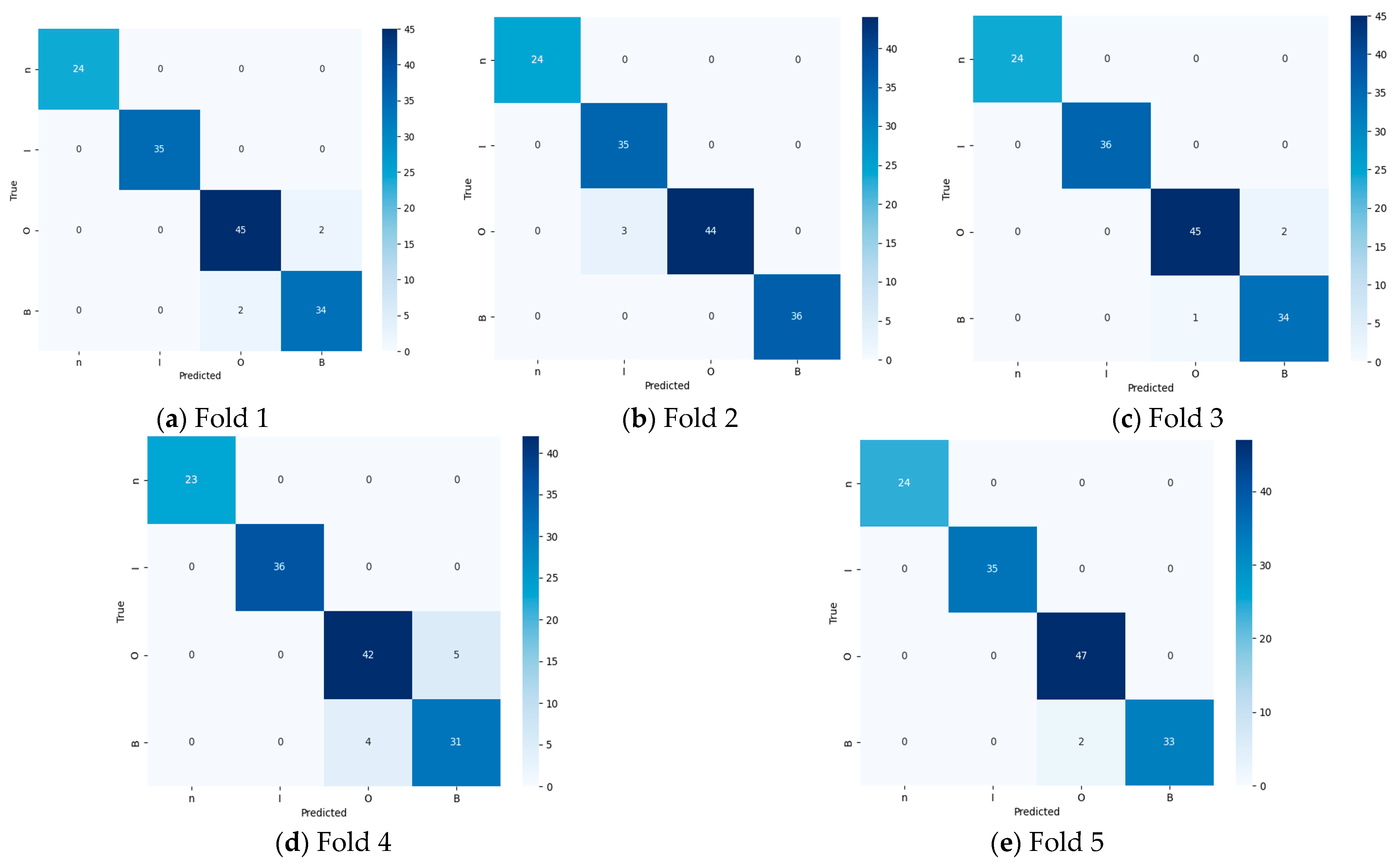
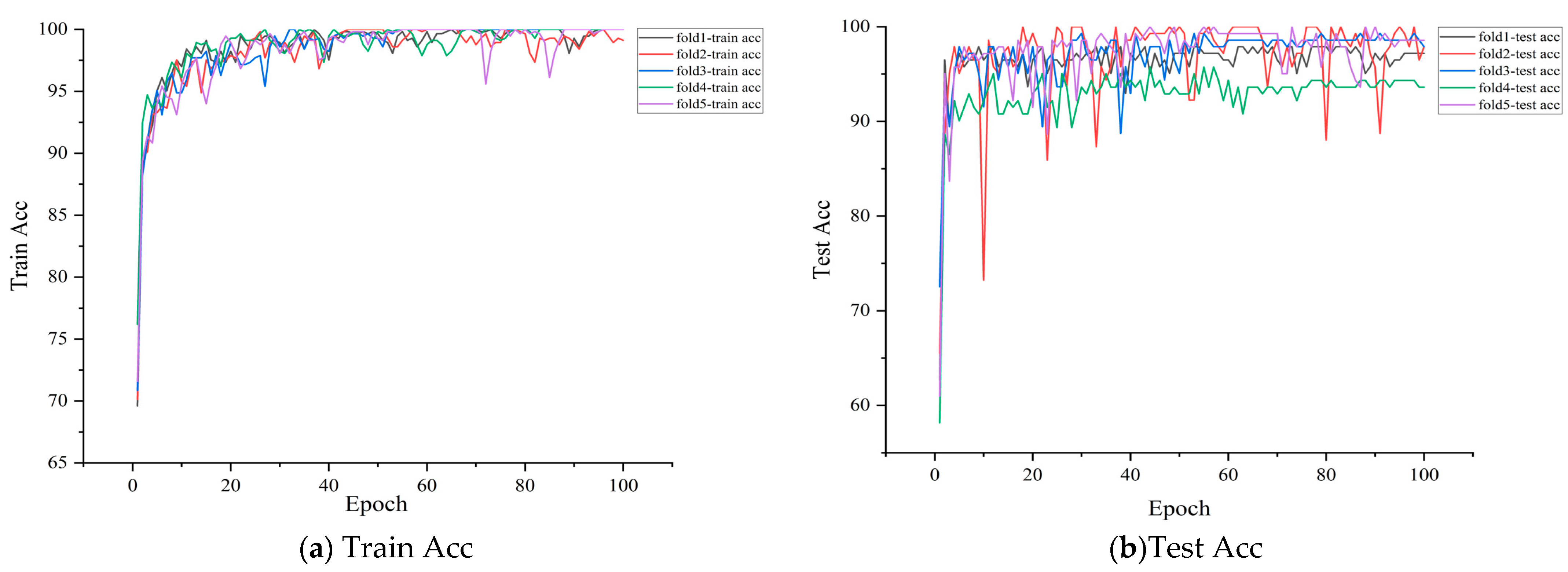

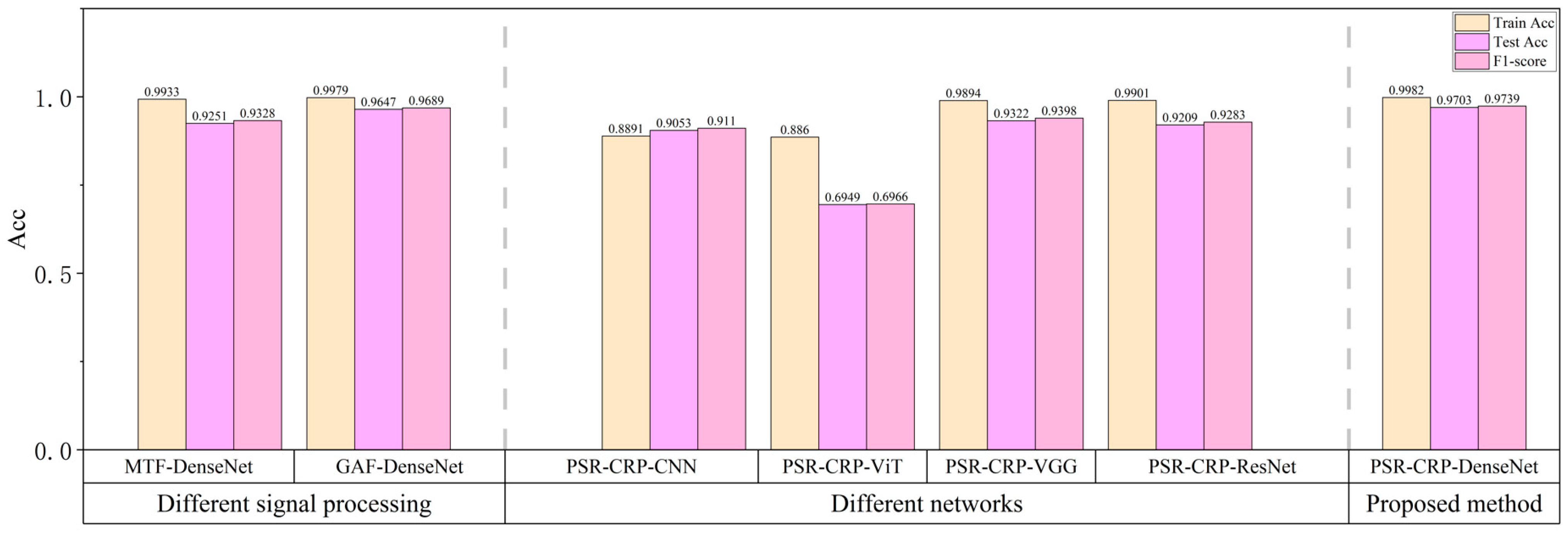
| Type | Fault Size | Number of Samples | Number of Labels | Label | Load | Sampling Rate |
|---|---|---|---|---|---|---|
| Normal | 119 | 119 | N (0) | 0 HP | 12 KHz | |
| Inner Ring Fault | 0.007″ | 59 | 177 | I (1) | ||
| 0.014″ | 59 | |||||
| 0.021″ | 59 | |||||
| Outer Ring Fault | 0.007″ | 118 | 236 | O (2) | ||
| 0.014″ | 59 | |||||
| 0.021″ | 58 | |||||
| Rolling Element Fault | 0.007″ | 59 | 177 | B (3) | ||
| 0.014″ | 59 | |||||
| 0.021″ | 59 |
| Type | Rotational Speed | Fault Size (Width × Depth) | Number of Samples | Number of Labels | Label | Sampling Rate |
|---|---|---|---|---|---|---|
| Normal | 800 rpm | 41 | 82 | N (0) | 50 KHz | |
| 1000 rpm | 41 | |||||
| Inner Ring Fault | 800 rpm | 0.3 × 0.25 mm | 30 | 60 | I (1) | |
| 1000 rpm | 30 | |||||
| Outer Ring Fault | 800 rpm | 0.3 × 0.25 mm | 30 | 60 | O (2) | |
| 1000 rpm | 30 | |||||
| Rolling Element Fault | 800 rpm | 0.5 × 0.15 mm | 30 | 60 | B (3) | |
| 1000 rpm | 30 |
| Parameter | Value |
|---|---|
| growth_rate | 32 |
| block_config | (6, 12, 24, 16) |
| drop_rate | 0.6 |
| num_classes | 4 |
| num_epochs | 100 |
| learning_rate | 0.0001 |
| batch_size | 32 |
| Serial | Model | Average Train Acc | Average Test Acc | F1 Score | Test Accuracy Improvement | F1 Score Improvement |
|---|---|---|---|---|---|---|
| 1 | MTF-DenseNet | 99.33% | 92.51% | 0.9328 | 4.52% | 0.041 |
| 2 | GAF-DenseNet | 99.79% | 96.47% | 0.9689 | 0.56% | 0.005 |
| 3 | PSR-CRP-CNN | 88.91% | 90.53% | 0.9110 | 6.5% | 0.063 |
| 4 | PSR-CRP-ViT | 88.60% | 69.49% | 0.6966 | 27.54% | 0.277 |
| 5 | PSR-CRP-VGG | 98.94% | 93.22% | 0.9398 | 3.81% | 0.034 |
| 6 | PSR-CRP-ResNet | 99.01% | 92.09% | 0.9283 | 4.94% | 0.046 |
| 7 | PSR-CRP-DenseNet | 99.82% | 97.03% | 0.9739 | ||
Disclaimer/Publisher’s Note: The statements, opinions and data contained in all publications are solely those of the individual author(s) and contributor(s) and not of MDPI and/or the editor(s). MDPI and/or the editor(s) disclaim responsibility for any injury to people or property resulting from any ideas, methods, instructions or products referred to in the content. |
© 2025 by the authors. Licensee MDPI, Basel, Switzerland. This article is an open access article distributed under the terms and conditions of the Creative Commons Attribution (CC BY) license (https://creativecommons.org/licenses/by/4.0/).
Share and Cite
Cui, B.; Tan, Z.; Gao, Y.; Wang, X.; Xiao, L. Research on a Fault Diagnosis Method for Rolling Bearings Based on the Fusion of PSR-CRP and DenseNet. Processes 2025, 13, 2372. https://doi.org/10.3390/pr13082372
Cui B, Tan Z, Gao Y, Wang X, Xiao L. Research on a Fault Diagnosis Method for Rolling Bearings Based on the Fusion of PSR-CRP and DenseNet. Processes. 2025; 13(8):2372. https://doi.org/10.3390/pr13082372
Chicago/Turabian StyleCui, Beining, Zhaobin Tan, Yuhang Gao, Xinyu Wang, and Lv Xiao. 2025. "Research on a Fault Diagnosis Method for Rolling Bearings Based on the Fusion of PSR-CRP and DenseNet" Processes 13, no. 8: 2372. https://doi.org/10.3390/pr13082372
APA StyleCui, B., Tan, Z., Gao, Y., Wang, X., & Xiao, L. (2025). Research on a Fault Diagnosis Method for Rolling Bearings Based on the Fusion of PSR-CRP and DenseNet. Processes, 13(8), 2372. https://doi.org/10.3390/pr13082372






